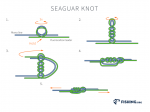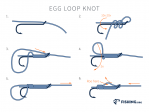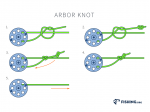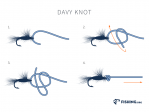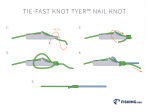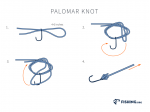The Trilene Knot was developed by Berkley, and although intended explicitly for monofilament lines, it can also work with fluorocarbon fishing lines.
The Trilene Knot goes by several names. These titles include the “Two Turn Clinch Knot” and the “Default Knot.” This is a stable and reliable link for joining monofilament or fluorocarbon to swivels, snaps, hooks and artificial lures.
It is one of the best fishing knots to use because of its performance. You can use this knot with fishing lines that have hooks and feel confident you will catch plenty of fish.
Why is the Trilene Knot Known as the Default Knot?
There is something unique about the Trilene Knot, and it is why many fishermen and women refer to it as the “Default Knot.”
This tying method is one that stands the test of time for its versatility and strength.
Every person who fishes, whether for fun or sport, loves a knot that allows for a variety of attachments to lures, snaps, or bait. This makes it a popular knot, used by many.
Since fishermen and women prefer to apply this knot, it seems it would be easy to make, but tying the knot itself typically requires the use of some dexterity.
The level of difficulty depends on what lure or line you use, but if you want simplicity, it is best to use the classic hook to start. After a few uses, tying a Trilene Knot will become second nature.
Anglers consider the Trilene Knot a "100% knot" for when a line breaks, it often breaks above its rated strength and not at the knot.
This knot maintains up to 90% of its original strength after you cast the line into the water and catch a few fish.
The power of the line remains stable.
Less breakage of a fishing line means you can spend more time fishing.
Make a Trilene Knot Using This Step-By-Step Guide
These steps are for beginners who are starting out with a classic hook and want to make a Trilene Knot.
Take the line you are using and put it through the eye of the hook, a . k . a. an eyelet, hook eye, or loophole (like when you thread a needle.)
Repeat this action by taking the end of the fishing line and putting it through the same eye of the hook. It needs to go in the same direction as the first time. Now, there should be another loophole that formed by the line itself or what looks like a double loop.
Once again, take the end of the line and tightly wrap it around the fishing line, just above the loophole or eye of the hook 5-6 times. You want the line to move gradually upward with each wrap. Keep in mind there should be enough of the standing line left over to take the tag end and thread it through the artificial loop made by the fishing line itself (which you did in Step One.)
Now, tug at the end of the line after wetting it with water to ease further tightening of the knot's strength without damaging the line.
Step Five
Finally, cast the line into the water and wait for a pull.
Although Trilene Knot's strength is high, there are other fishing knots to try out for different reasons. For instance, the Uni Knot is a tie knot easy to make with knot strength.
The knot you choose may also depend on the type of fishing you plan on doing.
For example: When Fly-fishing, there is a list of specific gear you need to set up. Some items you will need are the fly rod, fly reel, fly line, and flies. You also need to know how to connect all of those trout-tempting flies to your line so you can cast them out to the trout. This calls for leader and tippet material to come into play.
If you are saltwater or freshwater fishing, the gear changes. You can say the same about the knot type you feel is best to use.
Other knots to learn for fishing:
Palomar Knot is another straightforward and secure fishing knot to use. It is an excellent tie knot for attaching a braided line and works well with tying a tag end of the line (Mono or Fluorocarbon lines.)
The more knots you know, the more you can enhance your fishing experience. If you want to avoid slippage, have line strength, and know-how to make an Improved Clinch Knot, then learning the Trilene Knot is essential.
Conclusion
When fishing, your goal is not only to catch fish but to ensure the line you use does not break. But if so, it should no longer matter to you now that you have learned how to tie a Trilene Knot.
Begin practicing, and you will feel a lot more comfortable with the Trilene Knot tying style and have even more fun catching all the fish you can.

 Joshua Keaton
Joshua Keaton 

